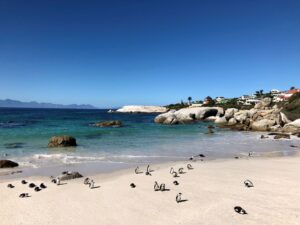To Travel or not to travel?
the divers for climate dilemma
Words by Sadiyah Rawat and Yolanda Waters
NB: This article is not about pointing fingers. It is about starting a conversation and growing community consciousness around an important and relevant issue. As travelers ourselves, we wanted to open a discussion as to how we as divers who are mindful of their carbon footprint can do better when it comes to traveling.
Here at Divers for Climate, and across the global dive community, we all have something in common – we love to travel. Whether it’s just up the road to our local dive site or on that exotic dive holiday that you’ve been planning for months, traveling plays a key role in our way of life – you could even say it’s a part of our identity. However, and this is a topic that comes up often for us, should we be traveling as those who supposedly “dive for climate”? The transportation sector is a major source of greenhouse gas emissions, accounting for a whopping 16.2% of global emissions. Of those 16.2%, 11.9% comes from road transport, 1.9% comes from aviation and 1.7% comes from shipping.
Now, if some of those global statistics don’t sound like a lot to you – let’s put them into perspective…
Transport is often the largest contributor to an individual’s overall carbon footprint. So, if you are trying to reduce your individual impact, reassessing your travel habits will likely cut your carbon footprint down by more than half, especially if you live in the Global North (where most of the emissions come from). And while there is an argument to be had that reducing your individual carbon footprint won’t impact global emissions by much (did you know that 100 companies are actually responsible for 71% of global emissions?), there is no denying that more carbon-neutral travel would be way better for the planet.
What’s more is that recreational scuba diving, freediving/snorkeling and at times even technical diving, fall under the tourism sector. And the largest source of carbon emissions for the tourism industry? Transportation. In fact, about 49% of the global tourism industry’s carbon footprint comes from travelling.
But what does this mean for the future of dive travel? Should we be feeling guilty? How can we help transition to a renewable future without giving up something that we love?
The truth is that travel and climate action is a complex, nuanced and slightly controversial conversation – but we are here to break it down.


Divers, travel and our impact on the climate
Think about your most recent dive trip. How did you get there? Which modes of transport did you use? It’s likely more than one. The drive to the dive centre, the van to the dive site, the boat out to sea. Maybe you had to take a flight or two, or spend a few nights on a liveaboard. Unfortunately, when our hearts are set on exploring the world’s coasts and oceans, travelling is inevitable. But while we are enjoying our well-earned travel time, our footprint on the planet grows bigger. And there are three main culprits:
1. flying
Let’s take a closer look at the aviation sector. While it accounts for only 2% of global greenhouse gas emissions, the majority of those emissions, about 81%, comes from passenger travel. Breaking it down further, when looking at passenger travel, international travels account for 60% of the emissions and domestic travels account for 40%.
What this means is that while international flights are still by far the worst in terms of impact, shorter flights are not much better. One flight from London to Sydney can emit over 1500kg of carbon dioxide per person (that’s more than some people per year), and one short flight from London to Rome? Almost 130kg per person per flight. In fact, in economy class, the rough calculation is about 285g per kilometre per person. For those flying business class – it’s even more.
While sustainable aviation fuels (SAFs) are being developed, they are nowhere near at the stage we need them to be, and they won’t be ready for years to come. It’s safe to say that flying is a pretty big deal for the climate.


2. driving
While flying might have the biggest impact in terms of emissions per person, road transport (i.e. driving) accounts for the majority of global transport emissions. Cars and trucks emit around 24 pounds (~11kg) of greenhouse gas emissions per gallon (~4.5L) of gas. To put that into perspective, it is estimated that globally, over 1 billion cars travel the streets each day. Now you don’t need to be good at maths to know that that is a lot.
For the last few decades, driving-related emissions from personal vehicles have been steadily increasing around the world and so transforming the way we get from A to B (or from dive site to dive site) and shifting away from fuel-based vehicles is considered a key climate solution.
3. boating/cruising
Cargo ships and cruises are the worst type of maritime transport when it comes to how much greenhouse gases they emit and how much oil and gas they release into the water, polluting our oceans. A cruise ship emits an estimated four times the amount of carbon per person than a flight. Not to mention the disastrous oil spills from cargo ships that seem to keep happening and how they result in near ecological collapse every time. However, even dive boats and speed boats, catamarans and liveaboards emit their fair share of carbon. On average, a dive boat burns through 1.9 gallons of fuel per day and that number varies with the distance travelled. As a diver, when choosing a liveaboard or a dive operator, choosing one that is climate aware and climate friendly (even carbon neutral if possible) is the best option.

But does that mean we should all just stop?
Of course not! We are not here to make you feel guilty or bad about taking a holiday. In fact, taking a break is an important part of climate work – we all recommend it. In the wise words of Rachel Cargle, “rest is revolutionary”. But we are here to help you consider a few things before your next dive adventure.
Carefully consider your travel plans
Traveling more climate-friendly can be as simple as more careful and environmentally considerate planning. For example,when planning your next dive holiday, if you have the option to take one straight flight instead of a layover and a second flight, the single flight option will have a lower carbon footprint. Some other things to consider when traveling abroad are:
- Packing lighter (every kilo counts when you’re flying)
- Choosing carbon neutral lodging
- Use public transport to get around
- Walking to as many places as you can
But more climate-friendly travel isn’t limited to those traveling overseas. For example, if you and your dive buddies are going to your local dive site, carpooling (sharing car travels) is also a great way to reduce emissions. Also consider if a journey can be done by coach or train, particularly if you’re traveling across the country.
Carbon offsetting
Just like most discussions within the climate space, offsetting is a tricky topic. Carbon offsetting is when individuals or companies invest in clean energy projects or pay a fee to an environmental scheme that takes carbon out of the atmosphere, thereby balancing or “cancelling” out their emissions. For example, most flight companies now allow you to calculate your carbon footprint and pay to offset your impact. In this way, theoretically, your flight becomes what we call ‘carbon neutral’. However, while carbon offsetting can be a useful tool in ensuring that our greenhouse gas emissions are not increasing, it is important to know that it is not the solution to the global climate emergency. We will break down carbon offsetting in a separate article in more detail, so keep an eye out!
Tourism and conservation
There is actually an interesting argument to be made for dive travel in helping to protect our marine ecosystems from climate change -where you travel and how you spend your money matters. In some cases, when you travel to a National Marine Park or a Marine Protected Area, it is not uncommon to pay a fee to dive and explore these places. For example, when you visit the Great Barrier Reef you have to pay a reef tax and when you visit the famous Bunaken National Marine Park in Indonesia, you have to pay a fee to dive. This money often goes towards the management and conservation of those marine ecosystems. By visiting these places, you are in fact, helping to conserve and preserve them. In these instances, tourism plays a key role in protecting and restoring these pristine marine environments.
Focus on the bigger picture
Assuming you’re not flying a private jet every other day, there are many other things you can do to help tackle the ocean-climate crisis. This is a global crisis after all, and focusing on the bigger picture and pushing for systemic change is always a productive step forward. If traveling or dive-related travel are an integral part of your life, you can focus your energy on other aspects of the climate crisis, for example: researching your local climate policy, advocating for your local government to take climate action, signing petitions and joining climate strikes, changing your bank, using solar panels to generate your own electricity, talking to your family and friends, joining an ocean-climate group and working together to demand an end to fossil fuels (the list goes on!). There are so many more things you can do. Remember that no one’s activism is perfect and the systems that design our society and way of life are even less so. So don’t be too hard on yourself.
Keep your eye out for our next few blogs where we’ll dive deeper in what we can do as divers to make our travels climate-friendly! Have anything to add to this discussion? Reach out to us on Instagram (@diversforclimate) or at diversforclimate@gmail.com


about the authors
Sadiyah Rawat, originally from Mauritius, is an oceanographer, dive master and freediver. Her research interests are the effects of climate change on marine ecosystems, more specifically, the Antarctic Large Marine Ecosystem.
Yolanda Waters from Australia is an environmental social scientist, dive instructor and coral reef enthusiast. Her research focuses on how to engage the public with ocean conservation behaviours, particularly those related to climate change.
